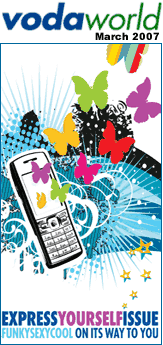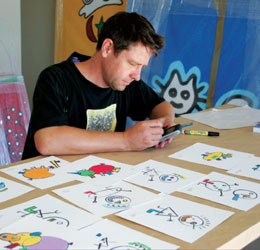|
News
2002

Summer

Autumn

Winter

Spring

2003
|
 |
|
 |
Unplugged creative expressions
 An insightful take on how cellphones are influencing art and other creative mediums.
An insightful take on how cellphones are influencing art and other creative mediums.
If art imitates life, then it seems only fitting that CELLPHONE technology is permeating onto the artistic canvas.
The constant evolution of what has already become an essential communication device has seen its function blur into a plethora of uses and functions.
Is it a camera, PDA, sketch pad, diary, television, web surfer… or a phone? This is the question developers and users have begun to grapple with as technology drives these devices to become smaller, yet still remain bursting with technology.
As any painter or photographer will tell you, you can never tell when inspiration may strike, or when the light will be ideal for that perfect shot. Short of lugging bulky cameras and whole canvases around with them, some artists have taken to embracing and using their always-at-hand cellphones for capturing these precious moments.
Websites such as Esato.com (www.esato.com) have emerged with forums specifically dedicated to hosting pictures taken with camera phones. The site was started in early 2000, mainly targeted at Sony Ericsson users, but it has grown into a bustling community with users able to upload their images for viewing on the site. To view the quality of these pictures, visit www.esato.comphonephotos.
But the capabilities of cellphones are not confined to taking photographs, and many progressive artists and creative people are using them in their creative processes too.
 Cape Town artist Richard Scott has already earned himself a reputation in art circles for his unique canvas - his Sony Ericsson cellphone. His innovative works saw him nominated for a Kebble art award a few years ago. Cape Town artist Richard Scott has already earned himself a reputation in art circles for his unique canvas - his Sony Ericsson cellphone. His innovative works saw him nominated for a Kebble art award a few years ago.
Scott draws and colours his creations on his cellphone, before Bluetoothing them to his PC to have prints made. His pieces have moved from smaller sizes to significant wall-sized paintings over the past few years and he has been invited to participate in two exhibitions in Belgium.
“Being the first to try and create something, in the art world, is what most artists seek to achieve… and then build a career on that discovery,” Scott explains.
He is not allowing the limitations of the cellphone to stunt his development and expression as an artist, and is in the process of “creating a movie using pixilated stills drawn on the phone. It will be an animated movie made of individual stills drawn on the phone in sequence.”
Scott believes that, as a mainstream creative medium, the cellphone “is far from reaching its goals in art circles”, as manufacturers are still divided between applications.
“Once these constraints have been broken through, only then will people accept work created on a phone as art. Perhaps phone manufacturers will develop a tool for artists. I’ll be first in the queue. In fact, I want to be on the design panel.”
Scott says he hardly even uses his device’s phone facility, primarily using the camera, drawing pad and music player.
Cape Town architect Martin Kruger of StudioKrugerRoos has been using his mobile phone’s sketchpad for several years now to jot down conceptual drawings and designs he thinks about when working on a new project.
The firm - and Kruger himself - has a host of big structures to its name, ranging from corporate skyscrapers to apartment blocks and low-income housing developments.
“I started using it a few years ago to scribble down conceptual drawings that I later Bluetooth to my computer and develop the idea further,” Kruger says.
He adds that he is constantly using the phone whenever ideas come to him and it is invaluable in capturing those momentary inspirations.
“I have been using the same phone ever since I started this and it is looking a bit tired now, and I should get a new one, but I like this one.”
Kruger says that he has only come across one other architect that uses a phone to draw on.
“It works for me. I don’t go into any detail on these drawings, but it really helps.”
|
|

